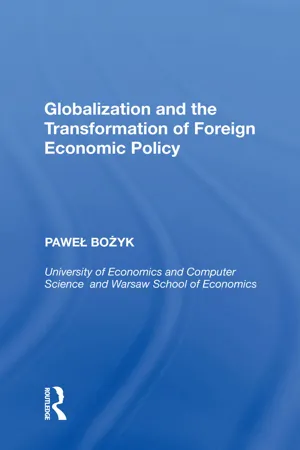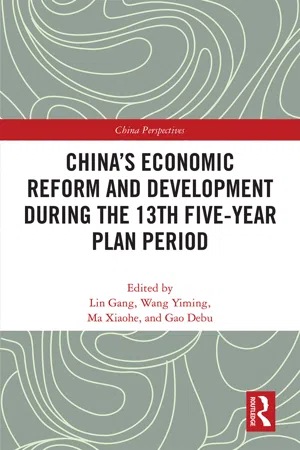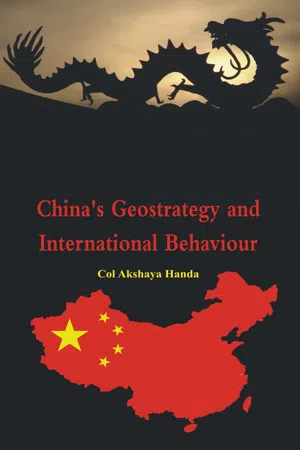Chinese Economy
The Chinese economy is one of the largest and fastest-growing in the world, characterized by its transition from a centrally planned to a market-based economy. It is driven by manufacturing, technology, and exports, and has experienced significant growth and development over the past few decades. The government plays a significant role in shaping economic policies and has implemented various reforms to sustain growth and stability.
5 Key excerpts on "Chinese Economy"
- Pawel Bozyk(Author)
- 2019(Publication Date)
- Routledge(Publisher)
...This is shown by the efficient management of the economy so far. The government, depending on need, can resort to sufficient tools either to accelerate or slow the rate of economic growth. For example, in 2000-2004, growth had to be decelerated to avoid overheating the economy. The government attained that goal by limiting state bank lending to unprofitable enterprises. To this end, it used central directives that were binding for banks. The high competitiveness of the Chinese Economy makes the country an increasingly active participant of globalization in the world economy. Meeting all the requirements of such participation, China is opening its economy to imported goods, services and factors of production. At the same time. China is a leading world exporter due to its high competitiveness in terms of both prices and quality. Globalization offers a chance for the development of the Chinese Economy through opening of international markets to Chinese goods. 9.4. China's Role in the Process of Globalization of the World Economy The system changes that took place in China in 1978-2005 were much deeper and more radical than those in Central and Eastern Europe. 17 They marked a transition from an orthodox communist system to a market economy based on private ownership. This was accomplished without the economic crises typical of Russia and other CEECs. As a result, China has transformed from a poor agricultural state to a medium-developed nation with a well-developed modern industry and vibrant research and development centres - a nation that today rivals Western Europe and other countries in space research. The achievements of the Chinese Economy are exemplified by the development of mobile telephone and computer production as well as Internet access. In many of these areas. China ranks second in the world after the United States...
- eBook - ePub
- Kerry Brown(Author)
- 2019(Publication Date)
- Bloomsbury Academic(Publisher)
...5 THE Chinese Economy The Chinese Economy is one of the wonders of the modern world. From constituting a tiny part of global GDP in 1978 at the start of the great transformation, China stood, in 2018, as the world’s second-largest economy (it had overtaken Japan in this position eight years earlier), making up over 15 per cent of the world’s economy. It was the world’s largest holder of foreign reserves, its largest exporter, second-largest importer and the largest user of all energy sources, apart from oil, where it stood a very close second to the USA. In terms of productivity, Chinese leaders were keen to say that, since the early 1980s, China’s economy had grown by 10 per cent per year, though since 2012 this had dipped to around 6.5–7 per cent. Even after the onset of the global financial crisis in 2008, China managed to add 40 per cent to its economy at a time when the rest of the developed world was stagnant. In the decade after its entry to the World Trade Organization (WTO) in 2001, China quadrupled the size of its economy. In terms of the rate and gross size of growth, China was either at the top of data tables or very close to it. Predictions of when it would overtake the USA to be the world’s largest economy varied between 2015 and 2035 – it was a question, in any case, not of if, but when. The Chinese Economy in 2018: Basic Data One of the first things most people notice about the PRC is that it is a country of big numbers. At the top of these sits the Chinese GDP rate. Since 1978, it has increased on average by 10 per cent each year, lifting China from 17th place in global rankings in 1979 to 2nd in 2018 (see Figure 5.1)...
- eBook - ePub
Socialism
Origins, Expansion, Decline, and the Attempted Revival in the United States
- Phillip Bryson(Author)
- 2021(Publication Date)
- PageTurner Press and Media(Publisher)
...Although the Chinese still have a planning sector, they have neither shared the Soviet ideological abhorrence of market outcomes nor remained outside the global economy. The equipoise between market and plan may be tipped by segments of the Chinese population which will expect and demand greater freedoms and efficiency for their society. The long-term prospects for liberty are strong given the prospects and constraints of the market and the global market. Problems remain, of course, but production has increased spectacularly over more than three decades in China. Foreign trade continues to thrive, investment capital pours in, incomes rise, and employment increases in an incredible manner. The market has brought unwonted prosperity to a surprisingly large share of the Chinese populace, so one is inclined to anticipate further market reform. In was not until 2015 that it became apparent that China’s economic performance is also blemished by a few warts. On the success side, Chinese growth has largely been a function of interaction with global markets. That success will also subtly promote market solutions. It has already begun to tie Chinese pricing to world market pricing. On the other hand, regional leaders have protected industry as their means of promoting it. As many regions adopted the same techniques, domestic trade wars and local protectionism became widespread. Chinese leaders have learned that selecting future production winners is a risky enterprise. The international economy cannot so blithely be rejected by a party or individual as the domestic market was in early experiments. If one can speak of the discipline of the domestic market, referring to the inescapable operation of powerful and predictable forces, one may speak of the punishment of the global market for nations ignoring or opposing its forces. This chapter discusses the history of reforms beyond the Deng era, noting their possibilities and limitations...
- Gang Lin, Yiming Wang, Xiaohe Ma, Debu Gao(Authors)
- 2020(Publication Date)
- Routledge(Publisher)
...It is extremely critical for China to improve the quality and efficiency of development during the 13th Five-Year Plan period, with concern to the profound adjustment of world economic growth pattern, continuous low growth rate, unstable and uncertain factors, as well as the weakening of its advantage in traditional competition in participation in economic globalization. In the past years, China’s export growth rate had slowed down to the single digit, to 7.9% both in 2012 and in 2013. From the perspective of trend, due to factors such as the adjustment of debt consumption patterns of the developed countries in the United States and Europe and the intensification of international competition, the past development methods have become unsustainable. Even if the world economy will maintain a moderate recovery, it does not mean that the external impetus for China’s growth can be as powerful as the time before the crisis. It is highly pressing to advance strategic adjustment in economic structure and optimize the proportion between supply, demand, regions, and elemental input. At the same time, in the complicated external environment, China will encounter increasingly more pressure to establish a comprehensive concept on quality and efficiency, solve the structural and systematic problems that have existed for a long time, and foster new advantage in international competition and cooperation. 2 Global Industrial Distribution Changes Exert Complex Impact on China’s Industrial Transformation and Upgrading After the international financial crisis, developed countries actively promoted reindustrialization, while the emerging economies and developing countries accelerated the industries with comparative advantages, which brought new changes to global industrial layout. Simultaneously, China continued its industrial transformation and upgrading and strengthened its competitive relations in industrial development with developed and developing countries...
- eBook - ePub
- Col Akshaya Handa(Author)
- 2014(Publication Date)
- VIJ Books (India) Pty Ltd(Publisher)
...Chapter 4 ECONOMY The People’s Republic of China (PRC) is the world’s second largest economy 1 by nominal GDP and by purchasing power parity after the United States. It is the world’s fastest-growing major economy, with growth rates averaging 10% over the past 30 years. China is also the largest exporter and second largest importer of goods in the world. On a per capita income basis, China ranked 90th by nominal GDP and 91st by GDP (PPP) in 2011, according to the International Monetary Fund (IMF). The provinces in the coastal regions of China tend to be more industrialized, while regions in the hinterland are less developed. Most economic growth of China is created from Special Economic Zones of the People’s Republic of China. However, still an estimated 100 million Chinese live below the poverty line 2 in 2012,and this has been estimated despite China setting a poverty line nearly 20% below the world standard. 3 History (a) By 1949, continuous foreign invasions, frequent revolutions and restorations, and civil wars had left the country with a fragile economy with little infrastructure. As Communist ascendancy seemed inevitable, almost all hard and foreign currency in China country were transported to Taiwan in 1948, making the war-time inflation even worse. (b) Since the formation of the PRC, an enormous effort was made towards creating economic growth and entire new industries were created. Tight control of budget and money supply reduced inflation by the end of 1950. Though most of it was done at the expense of suppressing the private sector of small to big businesses...




